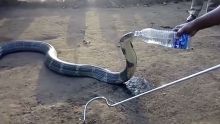The woman who became the richest person in Australia by developing some of the nation's vast iron-ore deposits has learned one key lesson from the last commodity bust - hire cheaper workers.
Billionaire Gina Rinehart is expanding her payroll to ramp up production from the Roy Hill mine in Western Australia's remote Pilbara outback. Many of her new employees get paid less because they have little or no mining experience, like Courtney Grove, 24, who studied animal health and science at university. Since last month, Grove has been driving a pink mining truck that shuttles 226 metric tons of ore at the $US10 billion ($13 billion) mine.
More World News Videos
A record year for the world's richest
Gina Rinehart was one of many billionaires who saw their fortunes increase dramatically in the last 12 months according to Forbes magazine.
Targeting so-called "greenies" who can be taught basic mining skills is part of Roy Hill's push to keep costs low in an age of global surpluses and to diversify its workforce. The iron-ore industry was hit hard by a three-year slump that eroded profit and left some companies stuck paying unskilled workers as much as $200,000 annually, twice the average salary in Australia. While prices have rebounded over the past year, the rally isn't expected to last.
"We need to be agile in terms of our cost base," Giles Lenz, Roy Hill's general manager of human resources, said by phone from the mine's processing plant in Pilbara. "We don't have any policies, work practices and legacy benefits that load up our cost base."
After hiring 858 people in the past 12 months, the company still needs to add another 650, and many will be newbies. Among those recruited are former farm workers, small business owners and even amateur netball players with the hand-eye coordination needed to drive a truck or operate heavy machinery. Netball is the country's most-popular organised sport for women. Ten players have taken jobs at Roy Hill so far, the result of company representatives scouting competitions across Western Australia.
Setting a lower cost base comes as the mine, like its rivals, can no longer rely on high prices. In 2011, iron ore -- the raw material used to make steel -- topped $US190 a metric ton in China, the top consumer. By 2015, it had tumbled below $US40 as rising output and a slowing global economy led to a surplus, according to Metal Bulletin Ltd.
While improved demand helped spur a rebound over the past year to $US94.86 in February, producers including BHP Billiton and Fortescue say they see supplies rising again to create a new glut. Prices will drop to $US58 in the final quarter of 2017, according to the median estimate among 13 analysts surveyed by Bloomberg, and slip to $US55 by 2019.
The dim outlook is forcing mine owners to figure out how to produce more with less, including adding automated diggers, drills and trucks, or halting investments on projects that need higher prices to be profitable.

Fortescue cut its cash cost of producing a ton of ore in half during the past two years, while BHP's fell more than 25 per cent in the second half of 2016, company filings show. Roy Hill, a closely held company, says its asset will be Australia's single largest iron ore mine at full production. The operation's costs were in the industry's lowest quartile, the producer said last year.
With all that belt-tightening, about 90 per cent of exporters would now be profitable with prices at $US60 a ton, well below current levels, according to researcher CRU Group.

Keeping costs in check is crucial for Roy Hill, which delivered its first ton of ore from the new Pilbara mine in late 2015 and hopes to produce 55 million tons this year from a deposit that could operate for three decades. The project incorporates cost-saving advances like a 344-kilometer (214-mile) rail line directly to its export terminal at Port Hedland and machines that are operated remotely from offices in Perth 1,000 kilometers south of the mine.
A lucrative profession
While an experienced worker at other mines in the state might have been paid about $150,000, Roy Hill offers around $100,000 for the same job, according to Lenz, the human resources manager. That's still more than the national average of $79,721, based on weekly earnings data from the Australian Bureau of Statistics. And the job has some appeal to those who like the idea of a rotation that calls for working two straight weeks at the remote mine and then a week off back home.

Roy Hill and other producers also are pushing for more gender balance in the male-dominated mining industry, where until recently women were banned from working underground in some countries. A more-inclusive approach expands the hiring pool and may increase the chances of employee retention by getting the right fit.
"This is an ability to recruit for character and teach expertise," said Chris Kent, national head of mining at London-based Hays Plc, a global recruitment and human resources company.
Diversifying the workforce
About 16 per cent of the mining workforce in Australia is female, compared with 37 per cent across all industries, according to the Workplace Gender Equality Agency. Women in mining earn A$US2,133 a week on average, 18 per cent less than men, according to the most recent data from the Australian Bureau of Statistics. That's still better than the national average for working adults of A$US1,592, the data show.
Melbourne-based BHP hopes to add 21,000 women to its payroll by the middle of the next decade.
At Roy Hill, having Australia's richest women in charge probably has helped to change the culture, according to Grove, the newbie who drives a Pilbara mine truck painted pink to honour women affected by breast cancer.
"It is nice to see the girls out on the machines," she said. "But I think mining will always have a boy's club mentality.''
Bloomberg
















